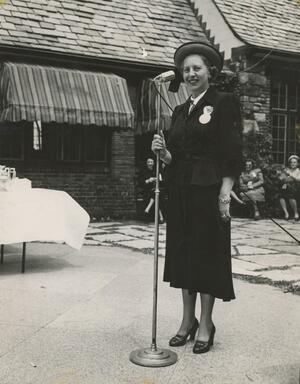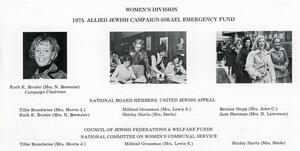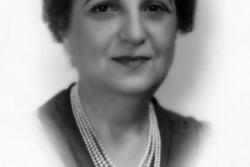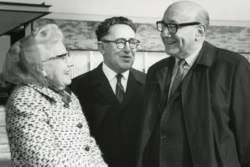From the Archives: The Challenge of Identification
This article is part of the series From the Archives. From the Archives highlights primary sources that have changed the course of history, for an individual, a community, or the world.
“And a widow no less than a married woman should always continue to use her husband's Christian name, or his name and another initial, engraved on her cards. She is Mrs. John Hunter Titherington Smith, or, to compromise, Mrs. J.H. Titherington Smith, but she is never Mrs. Sarah Smith; at least not anywhere in good society" ––Etiquette by Emily Post, 1922
I recently received a research request for a photograph of a woman named Gertrude Glogower. At the time, the only thing I knew about her was that she was a past president of the Greater Detroit section of the National Council for Jewish Woman, whose records we hold. A cursory search turned up little in our collection…until I discovered her husband’s name. While Gertrude Glogower was barely cited, Mrs. Samuel Glogower’s accomplishments were prolific. She was the first woman president of any Jewish Center in the United States, a board member of numerous charitable organizations, the first female recipient of the prestigious Frank L. Weil award. That just names a few of her achievements. Yet for all her work, she was never recognized by her own name––even in her 1979 Detroit Jewish News obituary, over forty years after the death of her husband, she was celebrated not as Gertrude but as Mrs. Samuel Glogower.
Identification is one of the biggest challenges for an archivist, particularly when it comes to identifying women. Whether on documents or photographs, most women were traditionally identified by their husband’s names rather than their own. Why was this the case? Was it for men to take credit for their wife’s successes? A method of control or ownership?
The terms Mrs. (as well as Miss) derives from the word “mistress.” According to the Etymology Dictionary, the first known use of “mistress” was in 1574. Samuel Johnson’s seminal 1755 dictionary relays seven definitions for “mistress.” They include hilariously diverse descriptions; a mistress can be a woman who governs; a woman beloved and courted; and a whore or concubine.
Consequently, seven types of women were synonymously trapped with one word––although none of Johnson’s definitions included “a married woman.” That came later, as did the advent of the abbreviation “Mrs.” to describe a married woman. In case you’re wondering, the abbreviation “Mr.” derives from “master.”
Is it any wonder that women, historically forced to be subservient to men, continue to be regulated to the position of a possession in archival work, with their husband’s––their master’s––name living on, instead of their own?
Today, the practice of calling a woman only by her husband’s name is typically limited to formal correspondence, but it didn’t change overnight. For women, gaining identities has been a process.
Take, for example, the Women’s Division of the Jewish Federation of Metropolitan Detroit formed in 1946. Ironically, it was started to encourage women to donate separately from their husbands. Yet, women were still listed under their husband’s names in the annual donor yearbook, just as they were on most administrative records. In the 1970s, as the second-wave feminist movement worked to give women––both married and single––more autonomy, first names slyly began to appear on certain documents. Meeting minutes would list attendance by the husband’s name, but by the woman’s first name in her donor report.
The archive is filled with photographs (and documents) of accomplished women who have no name but their husband’s, and while it is a personal goal to identify them, the records of the era can make it impossible. Still, we try to connect faces with first names, to make sure that Gertrude Glogower’s accomplishments are just as accessible as Mrs. Samuel Glogower’s, as often as we can and provide the forgotten woman with the acknowledgement she deserves.








